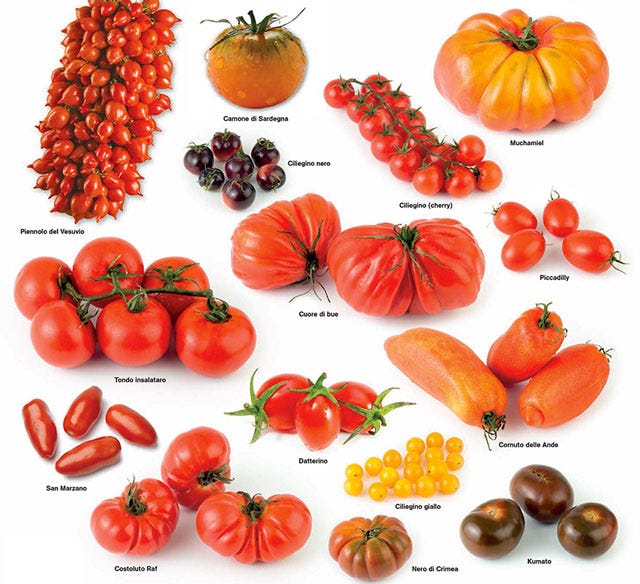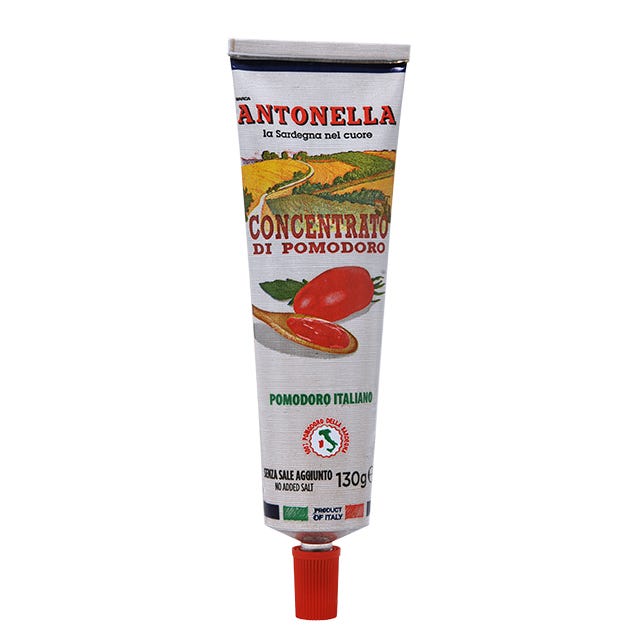Pomodoro
An attempt to clear up the confusion about tomatoes and sauces.
Spaghetti with tomato sauce is probably the dish that most people identify with Italy.
Yet there seems to be a lot of confusion about tomato sauce outside of Italy. This is probably because the terminology is in fact quite unclear and you often will have a hard time distinguishing passata from sugo, from salsa, from pummarola from pomodoro.
Let’s try to shed some light on tomatoes and sauces, at least as they are conceived in modern day Italy.
A bit of history
As you all know tomatoes are not native to Italy and they came into southern Italy probably from Mexico via Spain in the middle of the 16th century. Their acceptance into Italian culinary culture was very slow. They were originally seen as ornament plants and they often appeared in a round and yellow variety (hence the name pomo d’oro, golden apple). Interestingly enough most of the other European languages described this fruit using a variation of the word tomatl, derived from the Nahuatl Aztec language .
Because of the Spanish domination of Naples, tomatoes started appearing shyly after more than a century in cuisine treatises, the first one being by Antonio Latini in 1692. He has a recipe called Salsa di pomodoro alla Spagnuola (in the Spanish style). This recipe has tomatoes cooked very briefly on a brace (hot grill), so they can be peeled, and then they are cut into very small cubes and mixed with similarly cubed onions, chilli peppers, thyme, oil , salt and vinegar. This is still quite far from tomato sauce as we intend it today, and it reminds me of a type of Mexican salsa cruda (Pico de Gallo). Latini also mentions that this sauce is great to accompany boiled meats.
Perhaps I should open a parenthesis here to mention that although various formats of pasta were common in Italy from the late Middle Ages, they were mostly eaten with cheese, lard or butter (for the wealthiest), and very often used as an accompaniment to other foods. But that is another story and shall be told another time.
We have to wait until 1837 for a recipe that starts to look like what we would call a tomato sauce. We find it in a treatise called Cucina Teorico-Pratica by Neapolitan chef Ippolito Cavalcanti. Here goes the recipe written in Neapolitan Dialect
Vermicielli co le pommadore
Quann’è lo tiempo, pigliarraje tre rotola de pommadore, le farraje cocere, e le passaraje; po piglia no terzo de nzogna, o doje mesurelle d’uoglio, lo faraje zoffriere co na capo d’aglio, e lo miette dint’a chella sauza. Doppo scauda doje rotola di vermicielli, e vierdi vierdi li levarraje, e nce li buote pe dinto: falle chini di pepe, miettence lo sale, e poi vide che magne.
Vermicelli with tomatoes
When it’s the right season, you will take three rotoli of tomatoes, you will cook them and pass them through a mill. Then you take 1/3 of lard or two measures of oil, you will fry it with a garlic head and you will put it into that sauce. You cook two rotoli of vermicelli, you will remove them when they are still hard and you will throw them in; you will fill it with pepper, add salt and you will see what an amazing dish you will eat.
(A rotolo is a pre decimal unit very common in Italy, roughly 1 rotolo is 0.8-0.9 kg)
All of these early tomato sauce recipes are from the Neapolitan area and we have to wait until the 20th century to see tomato become widespread all over the peninsula. Many food historians now believe that tomato sauce became a pan Italian staple in the immigrant communities of the United States of America before than Italy. The dish of spaghetti with tomato sauce contributed in creating a strong cultural identity in the Italian American communities. This idea of Italian food was then re-imported into Italy as many migrants came back to the home country, and also exported to the rest of the world. It’s a complicated history and one that many Italians are not really or interested in discovering and accepting, but in case you want to know more, I do recommend two essential readings:
Luca Cesari - The discovery of pasta, A history in ten dishes
Massimo Montanari - A short history of Spaghetti with Tomato sauce
Pomodori
There are many varieties of tomatoes growing in Italy from June to September and some kinds work best eaten raw in salads, while others work best when cooked.
Usually tomato sauce is made using what we call perini tomatoes, they are oval and they are ripe at the end of the summer. For example the classic San Marzano tomato (from the Neapolitan area) or the Datterino tomato. Sometimes sweet cherry tomatoes are used as well. Italians are very opinionated on which type of tomatoes to use for what type of sauce but there are no set rules, only family traditions and personal opinions that come from experience.
In a not so far past, at the end of the summer, every respectable southern Italian household would have made tomato passata for the entire year. It was a big family operation that involved cooking massive amount of tomatoes, pushing them through a passaverdure (a vegetable mill that gives very different texture results to blending), jarring them and saving them in the cantina (the cellar) after sterilising the jars, or these days freezing them.
Check out this video to see what this operation looks like:
Tinned tomatoes
Francesco Cirio (bizarrely enough a northern man from Turin), was the entrepreneur who in 1856 first experimented using peeled tomatoes with the relatively new technology of conserving food by “tinning”. Cirio changed the history of Italian cuisine and there is no doubt that tinning and industrially conserving tomatoes made them very popular worldwide. Thanks to this technology and to Cirio, tomatoes became a staple of every Italian pantry, and part of the Italian diet throughout the year. Not many families nowadays still make passata by hand, and most Italians resort to tinned tomatoes for their daily dose of pasta.
Not all tinned tomatoes are the same and everyone has their own favorite brands. These days I enjoy the sweetness of Sardinian brand Antonella but you need to experiment with the brands that are available to you and do not forget my usual refrain: Italian food is made of very few ingredients so they all need to be of the highest quality!
Tinned tomatoes also come in different varieties and they have different functions according to how you like your sauce and what you are preparing:
Pomodori Pelati
These are basically whole tomatoes (usually San Marzano variety) quickly cooked, peeled and canned in tomato juice. They contain the seeds and they are the closest to fresh tomatoes.
I usually use pomodori pelati to make a simple chunky tomato sauce, or I use them on pizza after crushing them with my hands.
One of the biggest differences between the taste of pizza in Italy vs the rest of the world is the taste of the sauce. Most Italians in fact do not use a cooked tomato sauce on pizza, but crushed pomodori pelati dressed with oil and salt. The idea is that the oven cooks the tomatoes while the pizza cooks and the final flavour is much lighter and fresher.
Polpa di pomodoro
This cubed tomato pulp is quite similar to pomodori pelati but here the tomatoes are chopped roughly and canned with some tomato juice. They have no skin and usually no seeds. They are traditionally used for sauces that need longer cooking and chunkier textures.
Passata
Industrial passata is usually a smoother and less dense product, made from cooked and milled tomatoes in their liquids. Passata contains no skins and no seeds and it’s gently cooked. It’s probably the closest thing to a tomato sauce and you can add it to a soffritto when you have a short amount of time to make a salsa. There is also a chunkier version of passata called passata rustica, to be used when you need more texture to your sauce.
Concentrato di pomodoro
Tomato concentrate is a dry paste obtained through evaporation of all the liquids present in the tomatoes. It is very traditional to Sicily and until a couple of generations ago it was made at home by letting the passata dry out under the September sun on large tables until it was reduced to a concentrate pulp. It is traditionally used in sauces, soups and other culinary preparations to add a flavour boost, sometimes diluted with water. My nonna used it very often and, for example, she made the pasta alla Milanese I shared a while back using tomato concentrate and not tinned tomatoes.
Salsa di pomodoro
This is what I usually call “tomato sauce” in my writing, it’s the italian mother sauce! It starts from a basis of soffritto of aromatics (onions, carrots, celery or garlic gently cooked in olive oil) and it continues with the addition of tomatoes (fresh or tinned). It’s cooked for about 20-30 minutes and it’s seasoned with salt (some people use sugar to counterbalance the acidity of tomatoes but it really depends on the quality of your tomatoes to start with). Often herbs and aromatics can be added for extra flavour. Many people would push the sauce through a passaverdure mill at the end of the process to achieve a smoother consistency and to get rid of skins (when using fresh tomatoes).
Most people would make this sauce at home starting from tinned tomatoes (or passata when in a hurry), but as you can see in the picture here above, there are plenty of ready made tomato sauces available in the shops.
As usual with folk traditions, terminology can get quite blurry and imprecise. So a plate of pasta with tomato sauce can be called pasta col pomodoro, pasta con la salsa, pasta con il sugo, pasta con la pummarola.
Sugo
This term usually implies a more complex sauce which is based on soffritto cooked with tomatoes and other ingredients added, something like a slow cooked meat sauce, a ragu’, a puttanesca, an amatriciana etc…
As mentioned here above I have seen the term sugo di pomodoro sometimes also used to describe a simple tomato sauce.
I hope this has helped to clarify a bit the world of tomatoes in Italy, please do let me know in comments if you have any questions.
Watch this space as in the coming weeks as I will guide you through the way I make some simple classic tomato sauces.











Oh, my goodness. My head is spinning (in the best way). As the grandchild of Italian immigrants (from the 19 teens) and the daughter of a woman who wanted to adopt those "new" American cooking styles (in the 60s and 70s), I have been confused for years about all of this. While I love my Nana's delicious "sauce" from ground peeled tomatoes and tomato paste, I am excited to branch out a bit with this information! We always made "pasta fresca" in the summer with coarsely chopped roma tomatoes, basil, onions and garlic, and sometimes zucchini or yellow squash. It was so delicious!
Ah, thank you, fascinating! We have been growing San Marzano and Pomodoro Squisito; now I have to try Datterino. A little late this year for Western Washington, but with TLC we should be able to try fresh Datterinos by August!